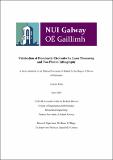| dc.contributor.advisor | Biggs, Manus | |
| dc.contributor.author | Kelly, Adriona | |
| dc.date.accessioned | 2020-06-09T09:30:03Z | |
| dc.date.available | 2020-06-09T09:30:03Z | |
| dc.date.issued | 2020-06-07 | |
| dc.identifier.uri | http://hdl.handle.net/10379/16015 | |
| dc.description.abstract | The brain machine interface BMI describes a group of technologies capable of communicating with excitable nervous tissue within the central nervous system (CNS). BMI’s have seen major advances in recent years, but these advances have been impeded due to a deterioration in the signal to noise ratio of recording electrodes over time. This deterioration has been attributed to an intrinsic host tissue response, namely reactive gliosis. Gliosis results in implant encapsulation via the synthesis of pro-inflammatory signalling molecules and the recruitment of glial cells. Thus, there is a clinical need to reduce tissue encapsulation in situ and improve long-term neuroelectrode functionality. Physical modification at the neuroelectrode active site could satisfy these requirements by integrating topographical signals to modulate neural cell behaviour and enhance electrochemical performance through increase in active surface area. In this study, commercially available platinum iridium (Pt/Ir) microelectrode probes and planar Pt/Ir and platinum substrates were nanotopographically (NT) functionalized using femtosecond/picosecond laser processing to generate laser induced periodic surface structures (LIPSS). Four different topographies and their physical properties were evaluated by scanning electron microscopy, interferometry, and atomic force microscopy. The electrochemical properties of these interfaces were investigated using electrochemical impedance spectroscopy and cyclic voltammetry. From these spectroscopy methods the impedance, electroactive surface area and charge injection capacity were determined. The in vitro response of mixed cortical cultures (embryonic rat E14/E17), was subsequently assessed by confocal microscopy, ELISA and multiplex protein array analysis. The recording ability of LIPSS functionalized and pristine controls were also assessed using ex vivo hippocampal slice cultures. An alternative laser processing technique (two photon lithography) was also optimized to facilitate the 3D printing of microfeatures through gold electroforming. Results indicated that LIPSS features improved the electrochemical properties of the electrodes, promoted cell alignment and modulated ion channel expression in mixed neuronal populations. To the best of our knowledge, neuroelectrodes functionalized with nanotopographical LIPSS features were demonstrated on a microwire probe for the first time. In this thesis we indicate the feasibility of LIPSS functionalisation of commercially available microelectrodes which is suggested could improve chronic neuroelectrode functionality whilst promoting an aligned cell network at the electrode interface. | en_IE |
| dc.publisher | NUI Galway | |
| dc.rights | Attribution-NonCommercial-NoDerivs 3.0 Ireland | |
| dc.rights.uri | https://creativecommons.org/licenses/by-nc-nd/3.0/ie/ | |
| dc.subject | neuroelectrode | en_IE |
| dc.subject | platinum/iridium | en_IE |
| dc.subject | LIPSS | en_IE |
| dc.subject | cell alignment | en_IE |
| dc.subject | astrogliosis | en_IE |
| dc.subject | electrochemical impedance | en_IE |
| dc.subject | Engineering and Informatics | en_IE |
| dc.subject | Biomedical engineering | en_IE |
| dc.title | Fabrication of biomimetic electrodes by laser processing and two photon lithography | en_IE |
| dc.type | Thesis | en |
| dc.contributor.funder | Science Foundation Ireland | en_IE |
| dc.contributor.funder | European Regional Development Fund | en_IE |
| dc.contributor.funder | Hardiman Research Scholarship, National University of Ireland Galway | en_IE |
| dc.local.note | The brain-machine interface BMI describes a device that directly couples the brain with a therapeutic recording system (using implanted neuroelectrodes) to control external devices. BMI has seen major advances in recent years, but these advances have been impeded due to a deterioration of the neuroelectrode recording ability overtime. This deterioration has been attributed to an immune tissue response, called reactive gliosis, Modification of the surface pattern of the implanted neuroelectrode could enhance the electrode’s recording capabilities, and improve the physical coupling between the electrode and the surrounding neural tissue, whilst reducing gliosis. | en_IE |
| dc.local.final | Yes | en_IE |
| dcterms.project | info:eu-repo/grantAgreement/SFI/SFI Research Centres/13/RC/2073/IE/C�RAM - Centre for Research in Medical Devices/ | en_IE |
| dcterms.project | info:eu-repo/grantAgreement/SFI/SFI Starting Investigator Research Grant (SIRG)/11/SIRG/B2135/IE/Engineering neuroelectrodes for deep brain stimulation through biomimetic conducting polymers/ | en_IE |
| nui.item.downloads | 497 | |


